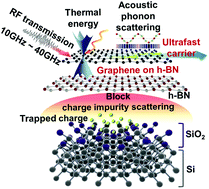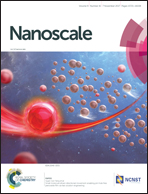Carrier scattering in quasi-free standing graphene on hexagonal boron nitride†
Abstract
Graphene, a two-dimensional material with a honeycomb lattice, has been promoted as a next generation material because of its ultrafast charge carriers and superior electrical properties. Hexagonal boron nitride (h-BN) is an insulator explored as an ideal substrate for graphene with lattice-matching. Using raido-frequency (RF) transmission measurement which provides specific characteristics of carrier scattering in a device, we profoundly investigated the electrical properties of quasi-free standing graphene on h-BN. RF devices with graphene supported and encapsulated with h-BN were fabricated to analyze the RF signal at low temperatures from 100 to 300 K. We demonstrated the carrier behavior in graphene with thermally excited carriers and acoustic photon scattering according to heat energy. Both h-BN supported and encapsulated graphene showed a significant enhancement in RF transmission, which is close to a gold interconnector. Our device with graphene on h-BN exhibited concealed nonlinear characteristics at a specific temperature of 180 K due to the internal effects of acoustic phonon scattering, while a usual device with graphene on SiO2/Si provided a linear variation. To anticipate the potential for electronic applications, the electrical circuit properties such as impedance, resistance, and inductance were extracted from the results of RF measurement.



 Please wait while we load your content...
Please wait while we load your content...